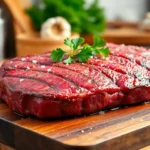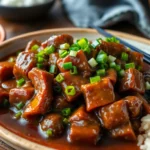Transport your taste buds to the tropical islands with our irresistible Hawaiian BBQ sauce that’s been stealing hearts across the Pacific for decades. This sweet and tangy masterpiece combines the perfect balance of pineapple juice, brown sugar, and soy sauce to create a flavor explosion that’ll transform any ordinary grilled dish into a luau-worthy feast.
We’ve perfected this authentic recipe that captures the essence of Hawaii’s famous plate lunch culture. Unlike store-bought versions loaded with preservatives, our homemade Hawaiian BBQ sauce delivers that genuine island taste with fresh ingredients you can pronounce. The secret lies in the harmonious blend of tropical sweetness and savory umami that makes everything from grilled chicken to pork ribs absolutely unforgettable.
Ready to bring the aloha spirit to your backyard barbecue? This versatile sauce works as a marinade, glaze, or dipping sauce, making it the ultimate addition to your grilling arsenal. Let’s jump into this simple yet spectacular recipe that’ll have your guests asking for seconds.
Ingredients
Our Hawaiian BBQ sauce brings together simple pantry staples with tropical elements to create that authentic island flavor. We’ve organized the ingredients into three categories to make preparation effortless.
For the Base Sauce
- 1 cup ketchup
- 1/2 cup soy sauce (low sodium preferred)
- 1/3 cup brown sugar (packed)
- 1/4 cup rice vinegar
- 2 tablespoons honey
- 2 tablespoons molasses
- 1 tablespoon sesame oil
- 1 teaspoon fresh ginger (grated)
- 3 cloves garlic (minced)
- 1/2 teaspoon onion powder
- 1/4 teaspoon black pepper (freshly ground)
For the Pineapple Component
- 1 cup fresh pineapple juice
- 1/2 cup crushed pineapple (drained)
- 2 tablespoons pineapple juice concentrate (optional for extra intensity)
Optional Add-ins
- 1/2 teaspoon red pepper flakes (for heat)
- 1 tablespoon liquid smoke (for smoky depth)
- 1 teaspoon Chinese five-spice powder (for complexity)
- 2 tablespoons bourbon or rum (for adult version)
- 1 tablespoon cornstarch mixed with 2 tablespoons water (for thickening)
Equipment Needed
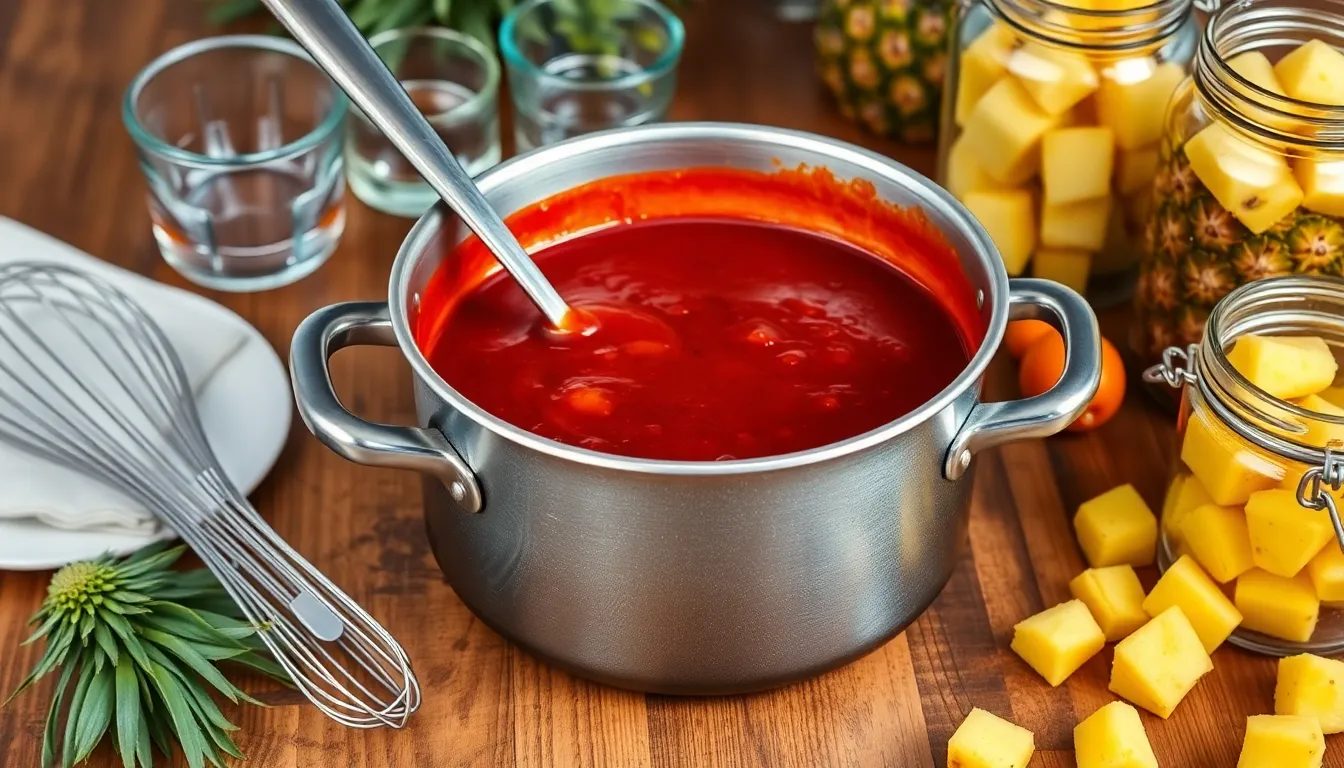
Making our Hawaiian BBQ sauce requires minimal kitchen equipment that most home cooks already have on hand. We recommend gathering these essential tools before starting the cooking process to ensure a smooth preparation experience.
Essential Equipment:
- Medium saucepan – We need this for combining and heating all ingredients together
- Wooden spoon or whisk – Either tool works perfectly for stirring the sauce as it simmers
- Measuring cups and spoons – Accurate measurements ensure consistent flavor every time we make this recipe
- Blender or food processor – This optional equipment creates an ultra-smooth sauce texture by thoroughly breaking down the pineapple pieces
Storage Equipment:
- Sealed container or glass jar – We use this to store leftover sauce in the refrigerator for up to 2 weeks
The beauty of this Hawaiian BBQ sauce lies in its simplicity. We don’t need any specialized or expensive equipment to create restaurant-quality results at home. Our standard kitchen tools handle every step of the process efficiently.
The blender or food processor becomes particularly useful when we want that perfectly smooth consistency. Without it we can still make delicious sauce, but the texture will be slightly chunkier from the crushed pineapple pieces. Both versions taste fantastic and work wonderfully as marinades or glazes for our grilled meats.
Instructions
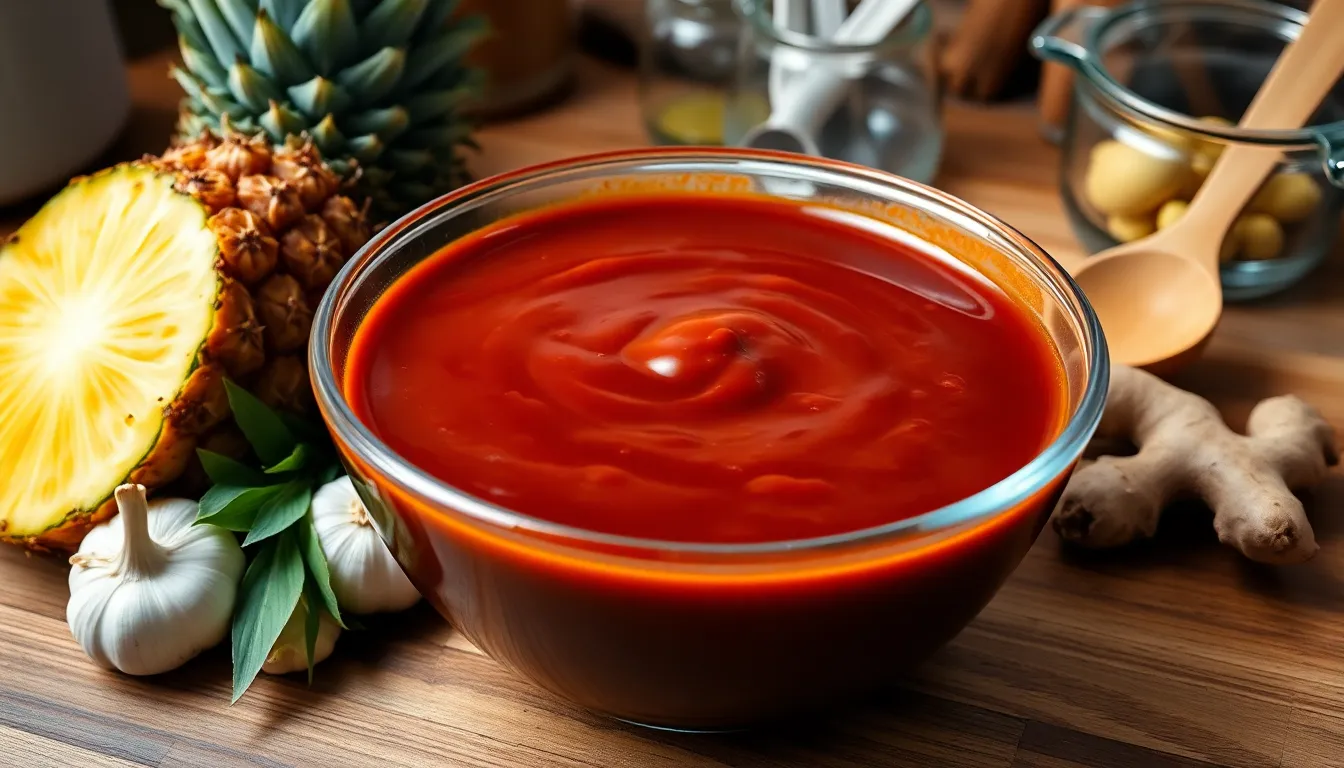
We’ll walk you through each step to create this flavorful Hawaiian BBQ sauce that brings authentic island taste to your kitchen. The process takes about 30 minutes from start to finish.
Prep the Ingredients
- 1 cup ketchup
- 1 cup brown sugar
- ⅔ cup soy sauce
- ½ cup pineapple juice
- 6 cloves garlic (minced or pressed)
- 2 tablespoons fresh ginger (finely grated)
- 2 tablespoons rice wine vinegar
- 2 tablespoons sesame oil
- 2 teaspoons Sriracha sauce
- Salt to taste
We start by gathering all our ingredients and preparing them for cooking. Mince the garlic cloves finely or use a garlic press for consistent flavor distribution. Grate the fresh ginger using the finest side of your grater to release maximum flavor. Having everything measured and ready makes the cooking process smooth and efficient.
Cook the Sauce Base
We combine the ketchup, brown sugar, soy sauce, garlic, ginger, rice wine vinegar, sesame oil, and Sriracha in our medium saucepan. Whisk these ingredients thoroughly until the mixture becomes completely smooth and uniform. The brown sugar should dissolve completely into the other ingredients. This base creates the foundation of our Hawaiian BBQ sauce’s complex flavor profile.
Add the Pineapple
We pour the pineapple juice into our saucepan mixture next. The pineapple juice brings that signature sweet and tangy Hawaiian element that distinguishes this sauce from traditional BBQ varieties. Stir the mixture well to incorporate the pineapple juice evenly throughout the sauce base.
Simmer and Thicken
We bring our sauce mixture to a rolling boil while whisking constantly to prevent any ingredients from sticking to the bottom. Once boiling, we reduce the heat to low and cover the saucepan. The sauce needs to simmer for approximately 25 minutes, stirring occasionally to ensure even cooking. During this time, the sauce thickens naturally and all the flavors meld together into a cohesive, rich taste.
Final Seasoning
We taste our finished sauce and adjust the salt level according to our preference. The sauce should have a balanced sweet, savory, and tangy flavor with a hint of heat from the Sriracha. Allow the sauce to cool slightly before using it on your grilled meats. Store any remaining sauce in a sealed jar in the refrigerator where it will keep fresh for up to two weeks.
Directions for Different Consistencies
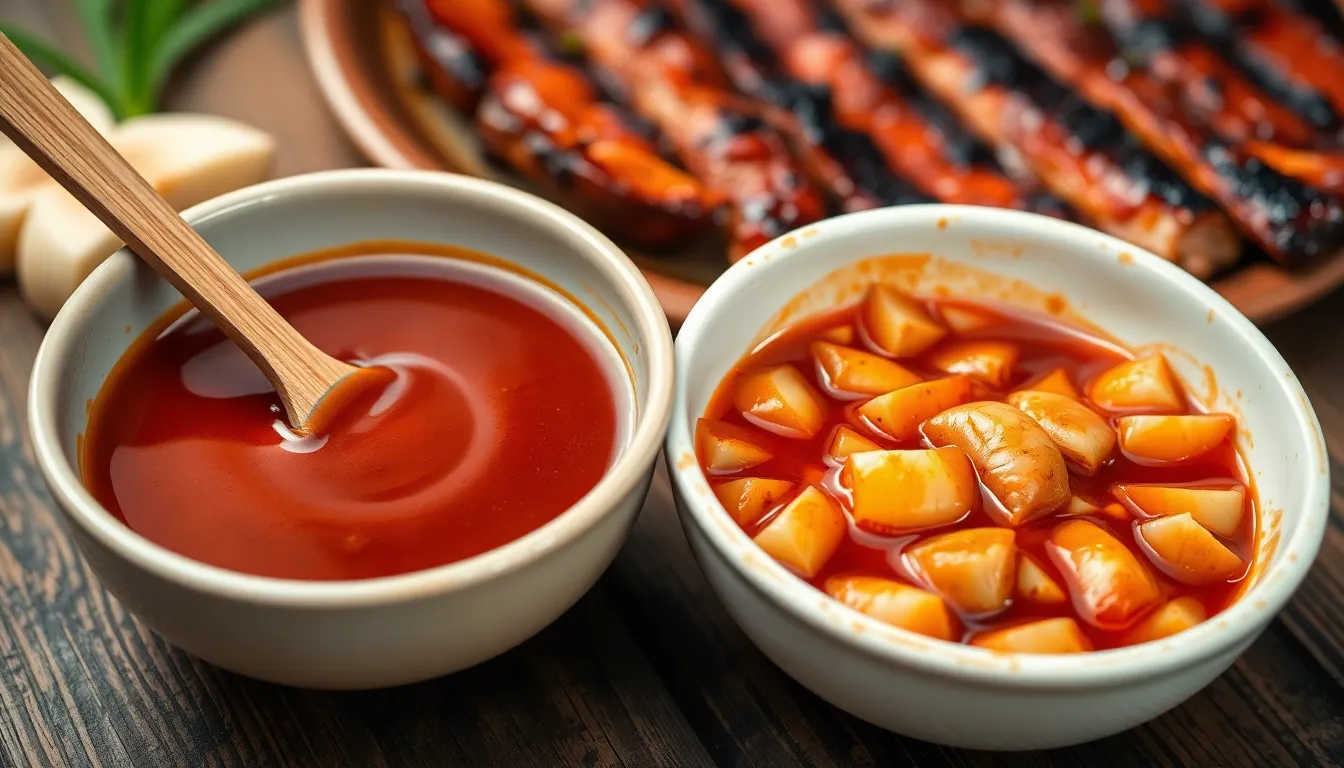
After completing the basic cooking process, we can customize our Hawaiian BBQ sauce texture to match our preferences. The choice between smooth and chunky versions depends on how we plan to use the sauce.
Smooth Hawaiian BBQ Sauce
We achieve a silky smooth consistency by transferring our cooled sauce to a blender after the 25-minute simmering process. Blend the mixture until it reaches a completely uniform texture without any visible pieces of garlic or ginger. For an ultra-smooth result, we strain the blended sauce through a fine mesh sieve to remove any remaining particles.
This smooth version works perfectly as a glaze for grilled meats or as a dipping sauce. We can store the finished sauce in an airtight container in the refrigerator for up to 2 weeks. The smooth consistency allows for even coating and professional presentation when brushing onto chicken or pork ribs.
Chunky Hawaiian BBQ Sauce
Our chunky version requires a different approach from the beginning of the cooking process. We chop the garlic and ginger into coarser pieces before adding them to the saucepan. This preserves their texture throughout the cooking time.
During the 25-minute simmering period, we stir occasionally to keep the chunky ingredients evenly distributed throughout the sauce. Avoid blending or processing the sauce after cooking to maintain the rustic texture. The visible bits of garlic and ginger create a hearty, homestyle appearance that adds visual interest to our dishes.
This textured version pairs excellently with grilled seafood and provides a more substantial mouthfeel. We store the chunky sauce using the same refrigeration method as the smooth version, maintaining freshness for up to 2 weeks.
Storage Instructions
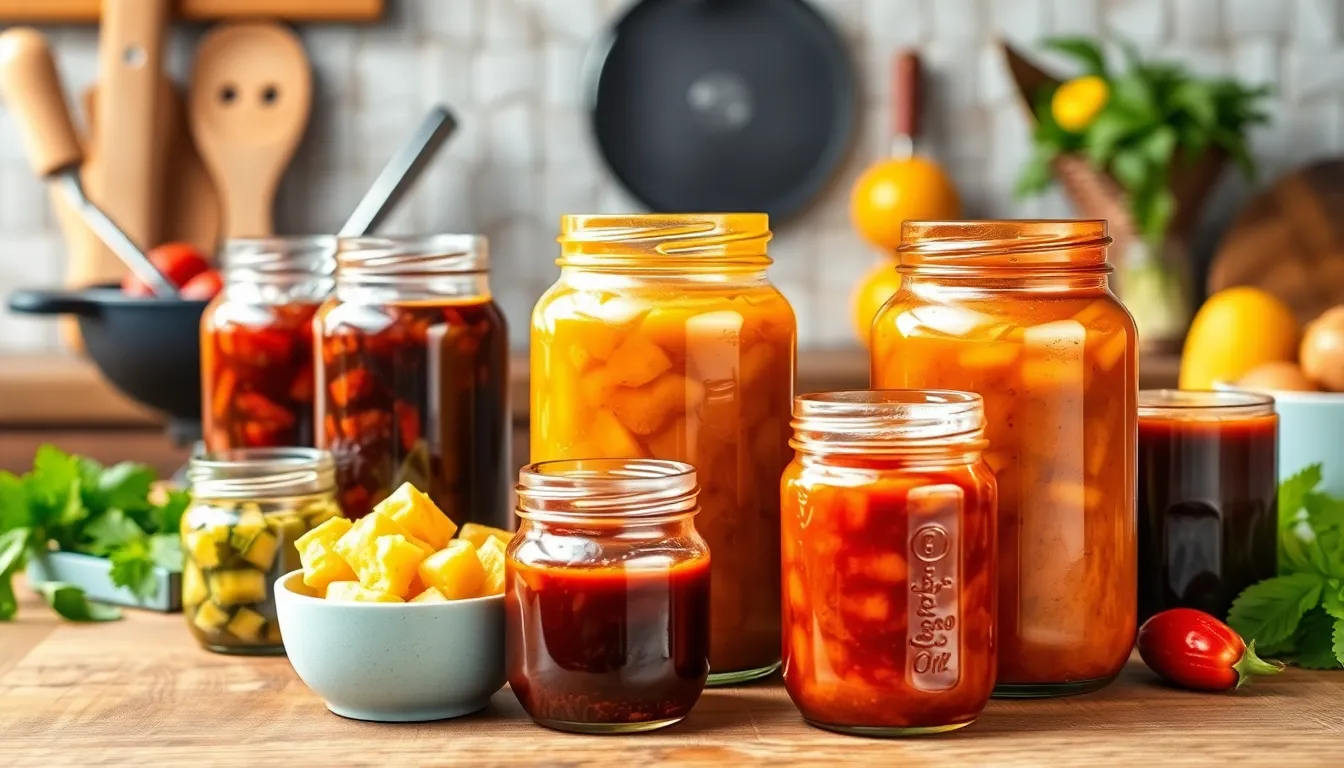
Proper storage techniques will help maintain the vibrant flavors and quality of your homemade Hawaiian BBQ sauce. We’ll guide you through the best methods to keep your sauce fresh for future grilling sessions.
Refrigerator Storage
Store your Hawaiian BBQ sauce in an airtight glass jar or container to preserve its sweet and tangy flavor profile. The sauce will maintain optimal quality in the refrigerator for up to 2 weeks according to standard storage guidelines. Some sources indicate that tightly sealed containers can extend this timeframe to 1 month.
Always use clean utensils when removing sauce from the container to prevent contamination. Glass jars work particularly well because they don’t absorb flavors or odors. We recommend labeling your container with the preparation date to track freshness.
| Storage Method | Duration | Container Type |
|---|---|---|
| Refrigerated | 2 weeks to 1 month | Airtight glass jar |
| Room Temperature | Not recommended | N/A |
Freezer Storage
Freezing extends the shelf life of your Hawaiian BBQ sauce significantly when done correctly. Place the sauce in an airtight freezer-safe glass jar or container, leaving approximately 1 inch of space at the top for expansion during freezing.
Your sauce will maintain quality for up to 3 months in the freezer. Thaw frozen sauce in the refrigerator overnight before using, and give it a good stir to restore its smooth consistency. We don’t recommend refreezing previously frozen sauce as this can affect both texture and flavor quality.
Label frozen containers with both the preparation date and freezing date for easy tracking. This storage method makes it convenient to prepare large batches during peak grilling season.
Serving Suggestions

Our Hawaiian BBQ sauce transforms ordinary grilled dishes into tropical masterpieces with its perfect balance of sweet pineapple and savory umami flavors. We’ve discovered countless ways to incorporate this versatile sauce into meals that go far beyond traditional barbecue.
Best Meats to Pair With
Chicken stands as the classic pairing for Hawaiian BBQ sauce. We recommend using it as a glaze for grilled chicken breasts or thighs, where the sweet and tangy flavors complement the meat’s natural taste perfectly. The sauce caramelizes beautifully during grilling, creating an irresistible golden coating.
Pork works wonderfully with our sauce’s sweetness, which balances the meat’s rich flavors. We love brushing it onto ribs during the final stages of cooking or using it as a finishing sauce for pulled pork and pork chops. The combination creates that authentic Hawaiian plate lunch experience.
Beef takes on new dimensions when paired with Hawaiian BBQ sauce. Short ribs and grilled flank steak benefit from the sauce’s tropical flair, while the pineapple’s natural enzymes help tenderize tougher cuts when used as a marinade.
Seafood offers surprising versatility with this sauce. Grilled shrimp and salmon particularly shine when glazed with our Hawaiian BBQ sauce, as the tropical pineapple notes enhance the ocean flavors without overwhelming them.
Creative Uses Beyond BBQ
Pizza sauce represents one of our favorite unconventional applications. We spread Hawaiian BBQ sauce as the base for pizza topped with ham, pineapple, and cheese, creating an authentic Hawaiian style pizza that rivals any restaurant version.
Sandwich spreads become instantly more exciting when we mix the sauce into mayonnaise or use it directly on burgers and sandwiches. This island inspired twist elevates ordinary lunch fare into something special.
Stir fries benefit from a tablespoon or two of our sauce added during the final cooking stages. We toss it with vegetables and proteins for a quick Hawaiian flavored meal that brings tropical warmth to weeknight dinners.
Salad dressing emerges when we thin the sauce with rice vinegar or sesame oil. This creates a tangy, sweet dressing that transforms simple greens into a tropical salad experience.
Roasted vegetables take on new life when we drizzle them with Hawaiian BBQ sauce before or after cooking. The sauce’s sweetness caramelizes root vegetables while adding depth to lighter options like bell peppers and zucchini.
Make-Ahead Tips

Planning ahead makes our Hawaiian BBQ sauce even more convenient for busy weeknights and weekend gatherings. We can prepare this sauce up to two weeks in advance and store it in the refrigerator without losing any of its vibrant tropical flavors.
Storage Timeline and Methods
Our homemade Hawaiian BBQ sauce maintains peak quality when stored properly in airtight containers. We recommend using glass jars with tight-fitting lids to preserve the sauce’s fresh taste and prevent any flavor transfer from plastic containers.
| Storage Method | Duration | Container Type |
|---|---|---|
| Refrigerator | Up to 2 weeks | Airtight glass jar |
| Freezer | Up to 3 months | Freezer-safe container |
| Meal prep portions | 1 week | Small sealed containers |
Batch Preparation Strategies
Making larger batches during peak grilling season saves us time and ensures we always have this flavorful sauce on hand. We can double or triple the recipe without affecting the cooking process or final taste. The sauce freezes beautifully in portion-sized containers that we can thaw as needed.
Cooling and Storage Best Practices
Complete cooling is essential before refrigerating our Hawaiian BBQ sauce to prevent condensation and potential spoilage. We allow the sauce to reach room temperature naturally before transferring it to storage containers. Using clean utensils prevents contamination and extends the sauce’s shelf life significantly.
Freezing portions in ice cube trays creates perfect single-serving sizes that we can pop out and use for individual meals. Once frozen solid we transfer these cubes to freezer bags for easy organization and space-saving storage.
Variations and Substitutions
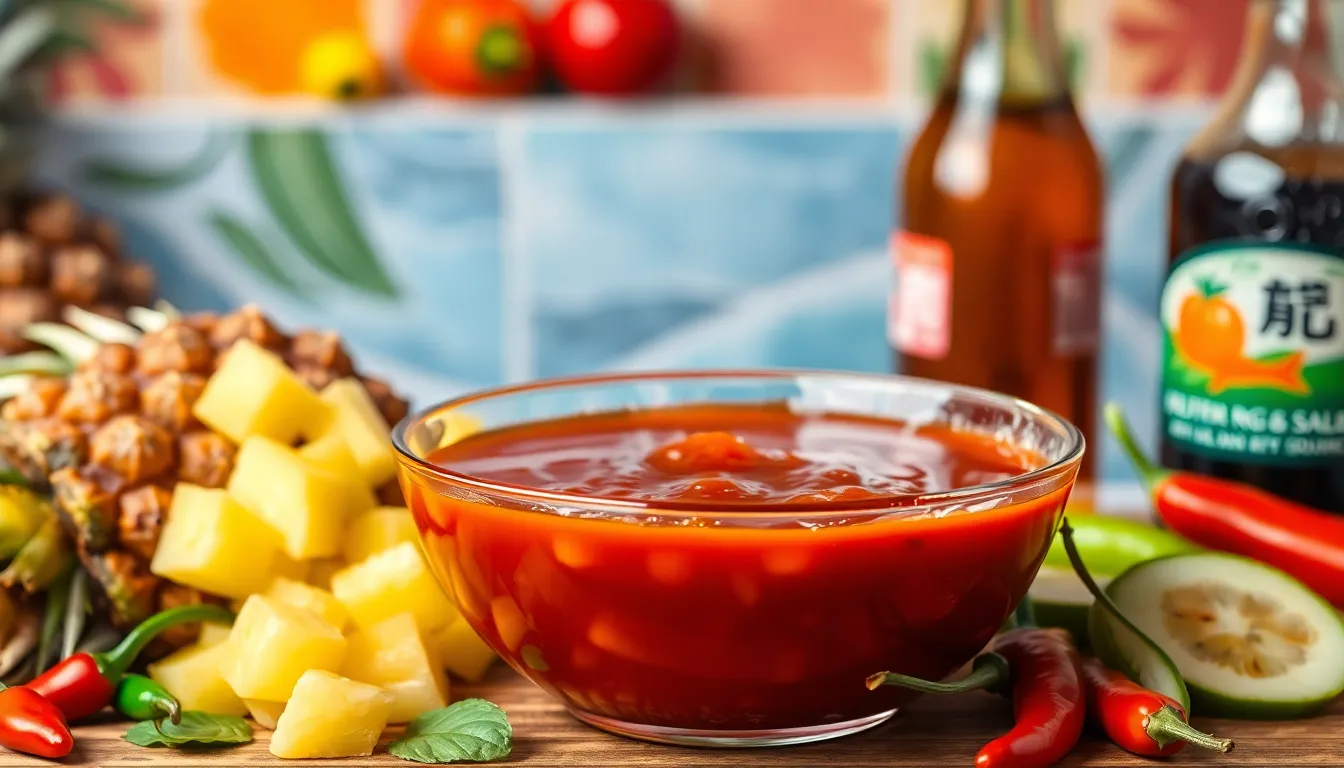
Our Hawaiian BBQ sauce recipe offers endless customization possibilities to match your taste preferences and dietary needs. These variations maintain the authentic tropical flavor profile while accommodating different spice levels and nutritional requirements.
Spicy Hawaiian BBQ Sauce
We love adding heat to our Hawaiian BBQ sauce for those who crave extra kick. Increase the Sriracha from 2 teaspoons to 1 tablespoon for noticeable warmth. Fresh chopped chili peppers work beautifully when added during the simmering process—try serrano or jalapeño peppers for moderate heat.
Cayenne pepper provides another excellent option for spice enthusiasts. Add 1/4 teaspoon initially and adjust to taste during cooking. Spicy brown mustard creates additional complexity while delivering heat—substitute 1 tablespoon for regular Dijon mustard in the base recipe.
The beauty of our spicy variation lies in its balance. The sweetness from pineapple juice and brown sugar tempers the heat perfectly. Start with smaller amounts of heat-generating ingredients and build gradually to achieve your desired spice level.
Sugar-Free Version
We understand the need for healthier alternatives without sacrificing flavor. Natural sweeteners replace brown sugar beautifully in our Hawaiian BBQ sauce. Honey provides rich sweetness—use 3/4 cup to replace 1 cup brown sugar and reduce cooking time slightly since honey caramelizes faster.
Maple syrup offers another excellent substitution with its distinctive flavor profile. Use 2/3 cup pure maple syrup instead of brown sugar for natural sweetness. Molasses creates deep complexity while eliminating refined sugars—substitute 1/2 cup molasses for the full amount of brown sugar.
We recommend relying more heavily on pineapple juice’s natural sweetness when creating sugar-free versions. Increase pineapple juice by 1/4 cup and reduce other liquids proportionally. This approach maintains the sauce’s signature tropical character while supporting healthier eating goals.
Vegan Hawaiian BBQ Sauce
Our base Hawaiian BBQ sauce recipe already aligns with most vegan requirements. The key consideration involves checking all ingredient labels for animal-derived components. Standard ketchup and soy sauce typically contain no animal products.
When recipes call for Worcestershire sauce, we substitute tamari or additional soy sauce to maintain umami depth. Tamari provides gluten-free benefits while delivering the same savory complexity. Use equal amounts as a direct replacement.
We replace honey with maple syrup or agave nectar when sweetening our vegan version. Both alternatives blend seamlessly during cooking and provide comparable sweetness levels. Agave nectar works particularly well since it dissolves quickly and doesn’t overpower the pineapple’s tropical notes.
The versatility of our Hawaiian BBQ sauce shines through these dietary adaptations. Each variation preserves the essential sweet-savory-tangy balance that makes this sauce perfect for grilled vegetables, plant-based proteins, and traditional barbecue applications.
Troubleshooting Common Issues
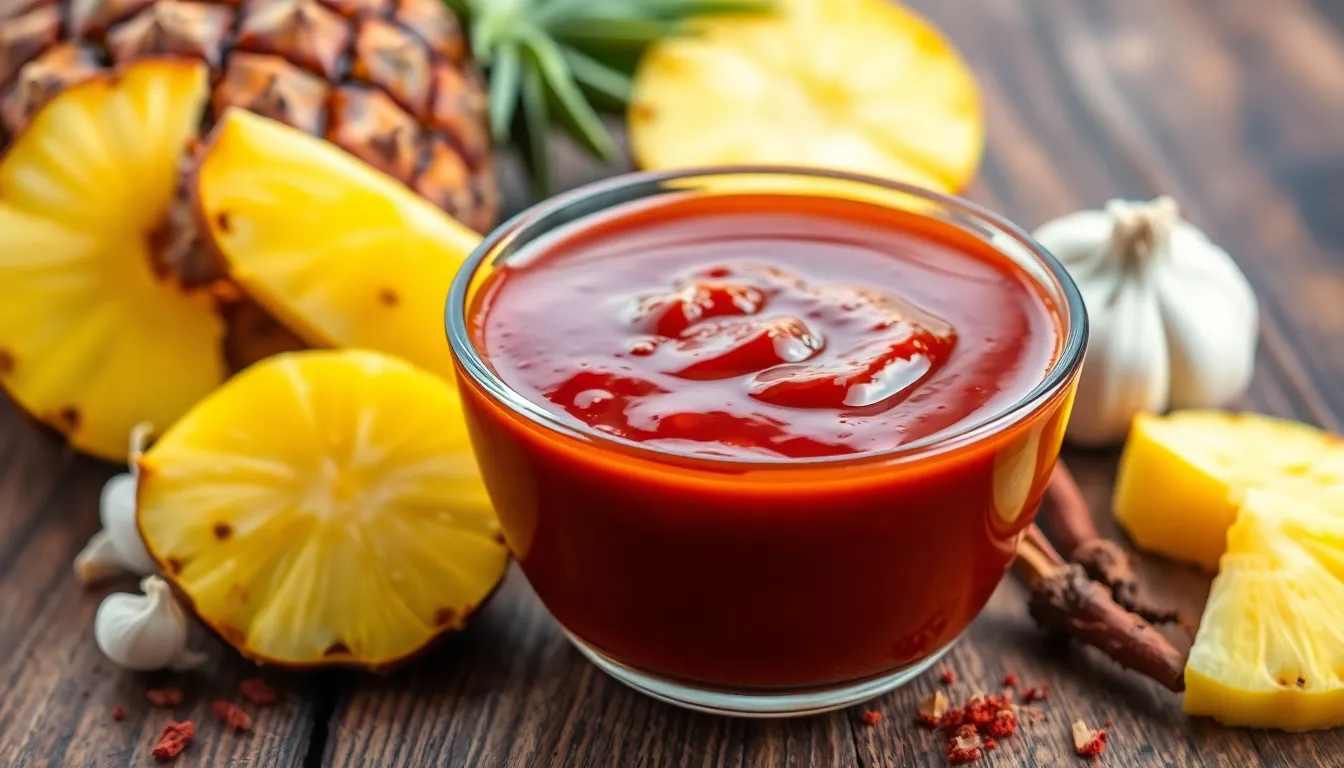
Even with the best intentions, our Hawaiian BBQ sauce might not turn out perfectly on the first try. We’ve compiled answers for the most common problems you might encounter while making this tropical favorite.
Sauce Turns Out Too Sweet
When your sauce tastes overwhelmingly sweet, we recommend reducing the brown sugar or coconut sugar by one third in your next batch. Balance the existing sauce by adding more rice wine vinegar or soy sauce gradually until you achieve the desired flavor profile. The key lies in tasting as you adjust rather than adding large amounts at once.
Excessive Saltiness Overwhelms Other Flavors
Overly salty sauce often results from using regular soy sauce instead of low sodium varieties. We suggest diluting the current batch with additional pineapple juice or adding more tomato base ingredients like ketchup. For future batches, switch to low sodium soy or teriyaki sauce to maintain better flavor control.
Sauce Lacks Depth and Complexity
A flat tasting sauce typically needs more smoky elements to achieve that authentic Hawaiian BBQ flavor. We recommend adding a few drops of liquid smoke or incorporating smoked paprika to create deeper flavor layers. Start with small amounts since these ingredients can quickly overpower the delicate pineapple notes.
Consistency Issues: Too Thin or Too Thick
Thin sauce frustrates many home cooks, but we can easily remedy this by simmering the mixture longer to reduce excess liquid. Adding tomato paste also helps thicken the consistency while maintaining flavor integrity. Conversely, overly thick sauce benefits from gradual additions of pineapple juice or water until you reach the perfect coating consistency.
Heat Level Problems
When your sauce becomes too spicy from excess Sriracha or cayenne, we balance the heat by adding more sweetness through honey or brown sugar. Additional pineapple juice also helps cool down the fire while maintaining the tropical character. Remember that heat builds over time, so taste your sauce after it cools completely.
Overpowering Garlic or Ginger
Strong aromatics can dominate your sauce’s flavor profile when using fresh ingredients. We recommend switching to garlic powder and ground ginger for more subtle flavoring in future batches. These dried alternatives provide the same aromatic qualities without the intense bite that fresh versions sometimes deliver.
| Issue | Quick Fix | Prevention |
|---|---|---|
| Too Sweet | Add vinegar or soy sauce | Reduce sugar by 1/3 |
| Too Salty | Dilute with pineapple juice | Use low sodium soy sauce |
| Lacks Depth | Add liquid smoke | Include smoked paprika |
| Too Thin | Simmer longer | Add tomato paste |
| Too Thick | Add pineapple juice | Monitor consistency while cooking |
| Too Spicy | Add sweetener | Start with less heat |
Most issues stem from ingredient ratios rather than technique problems. We always recommend making small adjustments and tasting frequently rather than trying to fix everything at once. Your sauce should achieve that perfect balance of sweet, savory, and tangy flavors that makes Hawaiian BBQ sauce so irresistible.
Conclusion
We’ve shared everything you need to create this incredible Hawaiian BBQ sauce that’ll transform your grilling game forever. With just a handful of simple ingredients and 30 minutes of your time you can create a sauce that rivals any restaurant version.
The beauty of this recipe lies in its flexibility – whether you prefer it smooth or chunky sweet or spicy there’s a variation that’ll suit your taste perfectly. Plus with proper storage techniques you can prepare batches ahead of time and always have this tropical flavor enhancer ready to go.
Now it’s time to fire up that grill grab your favorite proteins and let this homemade Hawaiian BBQ sauce take your backyard barbecues to the next level. Your family and friends will be asking for the recipe after just one bite!
Frequently Asked Questions
What makes Hawaiian BBQ sauce different from regular BBQ sauce?
Hawaiian BBQ sauce features a unique sweet and tangy flavor profile with pineapple juice and crushed pineapple as key ingredients. Unlike regular BBQ sauce, it incorporates Asian-inspired elements like soy sauce, sesame oil, and ginger, creating a tropical twist that captures the essence of Hawaii’s plate lunch culture.
How long does homemade Hawaiian BBQ sauce last?
Homemade Hawaiian BBQ sauce can be stored in an airtight glass jar in the refrigerator for up to two weeks. For longer storage, freeze it in airtight containers for up to three months. Always use clean utensils when handling to prevent contamination and maintain freshness.
Can I make Hawaiian BBQ sauce without pineapple?
While pineapple is essential for authentic Hawaiian BBQ sauce flavor, you can substitute it with other tropical fruits like mango or papaya. However, this will change the traditional taste profile. The pineapple provides the signature sweet-tangy balance that defines Hawaiian-style BBQ sauce.
What equipment do I need to make Hawaiian BBQ sauce?
You only need basic kitchen equipment: a medium saucepan, wooden spoon or whisk, measuring cups and spoons, and optionally a blender for smoother texture. A sealed glass jar for storage is recommended. No specialized tools are required, making it accessible for home cooks.
How can I adjust the consistency of my Hawaiian BBQ sauce?
For a smooth sauce, blend the cooled mixture and strain for ultra-smooth finish. For chunky texture, leave coarser pieces of garlic and ginger intact. If too thin, add cornstarch slurry; if too thick, thin with pineapple juice or water until desired consistency is reached.
What meats pair best with Hawaiian BBQ sauce?
Hawaiian BBQ sauce works excellently with chicken, pork, beef, and seafood. It’s particularly popular with grilled chicken thighs, pork ribs, beef short ribs, and shrimp. The sweet-tangy flavor complements both white and red meats, making it versatile for various grilling applications.
Can I make Hawaiian BBQ sauce vegan?
Yes, create a vegan version by substituting honey with agave nectar or maple syrup. All other ingredients are naturally plant-based. This maintains the essential sweet-savory-tangy balance while making it suitable for vegan diets and plant-based protein dishes.
How do I fix Hawaiian BBQ sauce that’s too sweet?
Balance overly sweet sauce by adding more soy sauce for saltiness, rice vinegar for acidity, or a pinch of salt. Taste as you adjust to prevent over-correction. The key is maintaining the sweet-savory-tangy balance that makes Hawaiian BBQ sauce distinctive.
Can Hawaiian BBQ sauce be used beyond grilling?
Absolutely! Use it as pizza sauce base, sandwich spread, stir-fry addition, salad dressing, or drizzle for roasted vegetables. Its versatility extends beyond traditional BBQ applications, adding tropical flavor to various dishes and transforming ordinary meals into island-inspired creations.
How far in advance can I make Hawaiian BBQ sauce?
You can prepare Hawaiian BBQ sauce up to two weeks in advance without losing vibrant flavors. For peak grilling season, consider batch preparation by doubling or tripling the recipe. Proper storage in airtight containers maintains quality and provides convenient ready-to-use sauce.

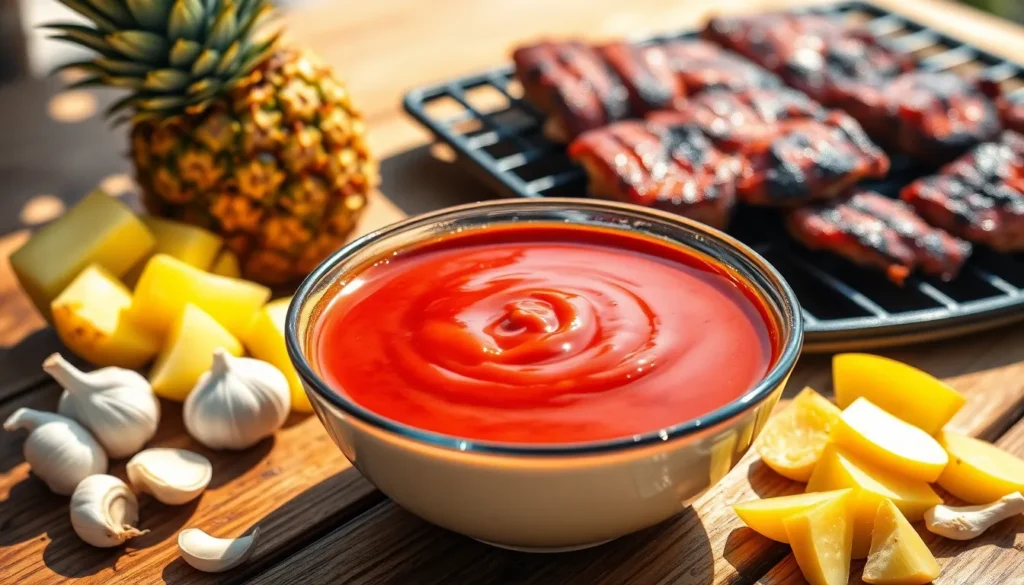











![[Dual-Directional Rotation] Electric Engraving Pen, Ultimate Cordless Engraving Pen for](https://m.media-amazon.com/images/I/511DT3f6pqL._SL500_.jpg)
![[Dual-Directional Rotation] Electric Engraving Pen, Ultimate Cordless Engraving Pen for](https://m.media-amazon.com/images/I/41CykL0t8oL._SL500_.jpg)
















